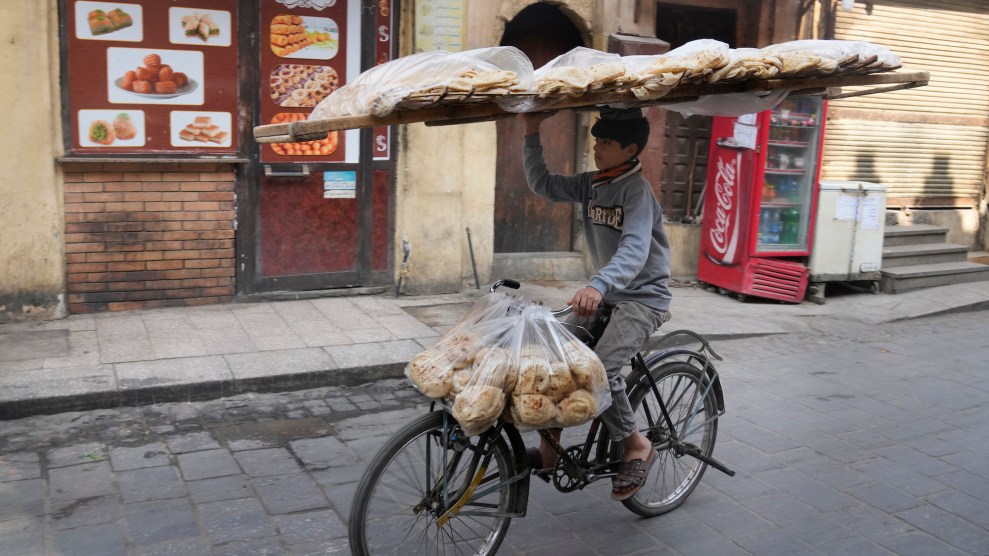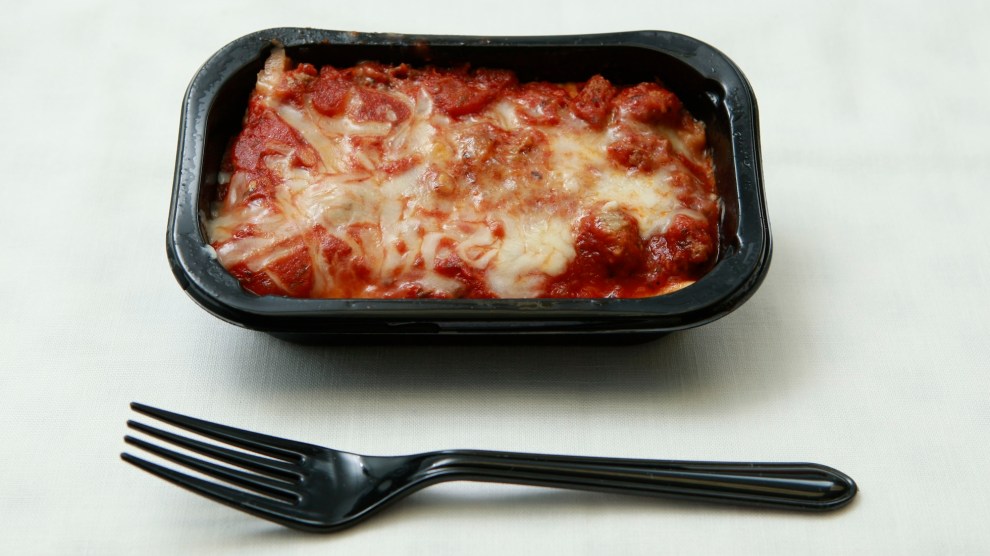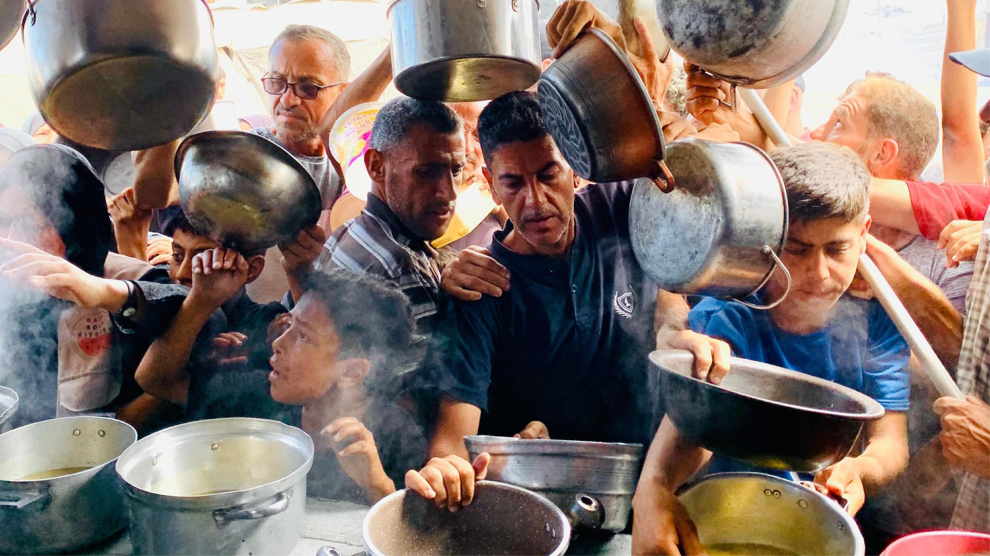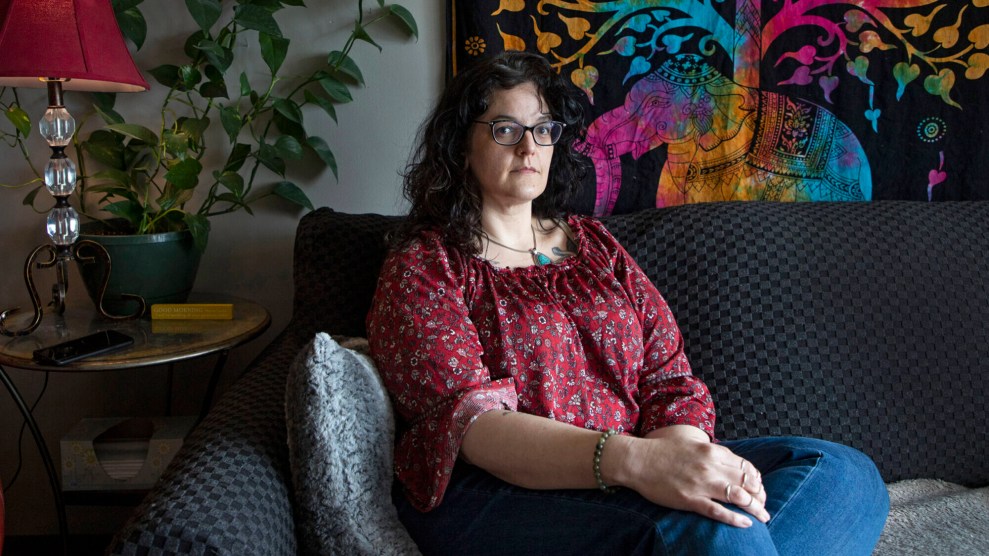
Tara Kramer, who suffers a disability, relies on food assistance to make ends meet. During the pandemic emergency, she received $250 a month in SNAP benefits and could buy a range of healthy foods, but her state recently cut those benefits to $20 per month.Emily Kestel/FERN
This story was originally published by the Food and Environment Reporting Network.
Tara Kramer hasn’t always had enough money to follow her doctor’s orders. She has a complex disability—hypermobile Ehlers-Danlos Syndrome, which causes chronic pain and mobility and digestive issues—and good nutrition and physical therapy could help keep her symptoms under control. But the healthy foods her nutritionist recommended were expensive, and the $16 per month she got in SNAP benefits didn’t go far. Physical therapy was costly, too, so she tried to use YouTube videos instead.
For Kramer, who lives in Des Moines, Iowa, the pandemic brought an unexpected reprieve from these struggles. As part of a spate of federal anti-hunger measures put into place in the spring of 2020, her SNAP benefits rose to $250 a month. These extra funds made it possible for Kramer to buy healthier food and pay for physical therapy. As her symptoms eased, she was able to go off two prescription medications for inflammation and nausea. Her chronic anemia disappeared.
But this month, Iowa ended these extra SNAP allotments, and her benefits dropped to $20. Now, with those extra funds gone, Kramer, 45, worries that her health will deteriorate again.
“The thought of going back to my former life from two years ago—my anxiety is up,” she said. For the last few weeks, she’s been skipping meals and losing sleep. “I am eating very modestly,” she said. “Some days, I’ll just have two cans of soup and I’m done for the day.”
Kramer is not alone. Anti-hunger advocates worry that the nation may be approaching a “hunger cliff” as emergency SNAP benefits are ending even as demand at food pantries—and Covid case numbers—are rising again.
When hunger and poverty spiked in the US at the beginning of the pandemic, the government responded with a number of temporary measures to strengthen the safety net: expanding unemployment benefits and access to healthcare, halting evictions, and making school lunches free for all students. It also massively expanded SNAP, which is the nation’s largest anti-hunger program and one of the largest US anti-poverty programs, serving more than 41 million people.
Under the temporary boost, SNAP households got at least $95 extra per month, and many, like Kramer, got hundreds more in what are known as emergency allotments. At their peak, in May 2021, the USDA issued $4.1 billion in emergency allotments to more than 19 million households. In February, the most recent month for which data were available, $2.8 billion in emergency allotments were distributed to more than 15 million households.
These benefits are tied to the National Public Health Emergency that was declared in March 2020 and has been subsequently extended multiple times. On Wednesday, the Biden administration extended the state of emergency until mid-July.
Yet a small but growing number of states have effectively opted out of these extra benefits already. Iowa, where Kramer lives, is one of 12 states—all led by Republicans—that have ended their pandemic emergencies without putting a narrower public health emergency declaration in place that would let them continue to provide these additional benefits from the federal government. Iowa Governor Kim Reynolds justified recent cuts to unemployment and other supports as a necessary step to get people back to work, warning that “the safety net has become a hammock.”
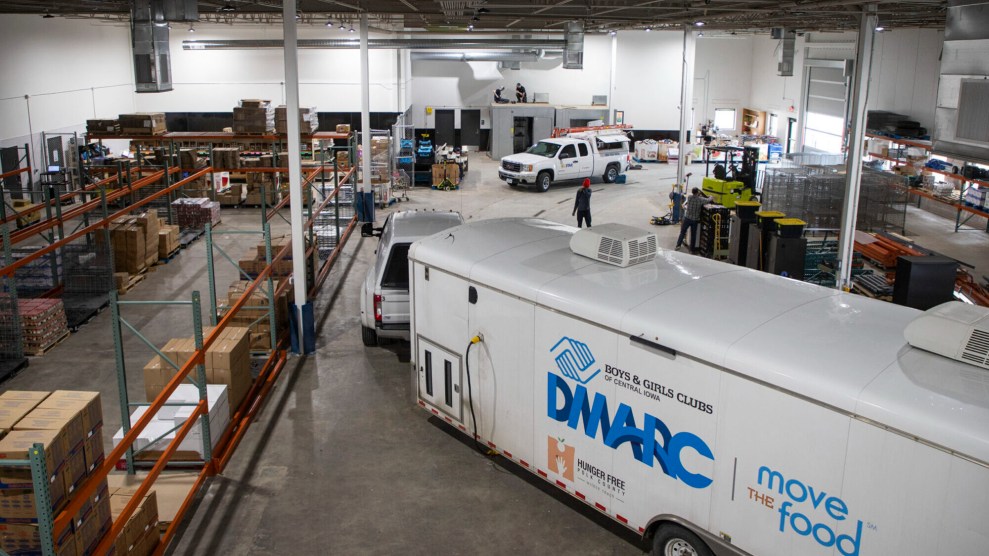
The Des Moines Area Religious Council runs a series of food pantries and has seen demand rise in the past three months.
Emily Kestel/FERN
But anti-hunger advocates say these cuts are cruel, not to mention far out of step with reality; people are still struggling much more than they were pre-pandemic and the majority of SNAP recipients are children, seniors or disabled. The timing of cuts in Iowa and in Wyoming, Kentucky and Indiana—all of which either ended emergency SNAP benefits in April or will do so in May—come as food and fuel prices reach record highs, Covid-19 cases are again on the rise, and other major supports, like monthly child tax credit payments, have ended.
The cuts also defy common sense, said Ellen Vollinger, SNAP director for the Food Research & Action Center, a nonprofit that works on poverty-related hunger issues. “It’s not a cost to the state. It’s fully federally funded. So if the states end those benefits prematurely, they’re foregoing federal money that could be coming to the state.”
Vollinger and other anti-hunger advocates warn that a “hunger cliff” could be imminent if more states or the federal government cut emergency SNAP benefits before people have truly recovered from the pandemic.
This has happened before. Food insecurity rose in the Great Recession’s aftermath, when emergency SNAP benefits were ended prematurely, and food banks and soup kitchens were overwhelmed. But people stand to lose much more this time around. In 2013, households lost $29 per month in benefits, on average. Today, the emergency allotments amount to $82 per person.
“It’s going to be sticker shock,” Vollinger said. “It’s going to reverberate through the economy. And it’s probably going to show up in the emergency feeding system, as people are going to have to figure out how to make do.”
In states like Florida, where emergency SNAP allotments ended in August 2021, food banks are straining to meet demand. It’s a “daily disaster” said Greg Higgerson, the chief development officer at the Second Harvest Food Bank of Central Florida in Orlando. Before the pandemic, the food bank was distributing about 150,000 meals worth of food per day. During the early months of the pandemic, that number shot up to 300,000 meals. But now, more than two years later, need remains extremely high—the food bank is currently distributing around 250,000 meals per day.
While it’s impossible to blame all of this increase on the end of emergency allotments, Higgerson said it’s definitely a factor, especially since it exacerbates other pressures that people face like higher food and fuel costs.
Kimberly Mendez, who lives in Miami-Dade County and lost her restaurant job during the pandemic, saw her SNAP benefits drop from $397 to $250 per month in August. Her benefits don’t even last half the month, but she’s figured out ways to stretch her food as far as possible. That means decreasing the amount of fish and meat the family eats, carefully weighing how much produce she buys and limiting how much milk her 14-month-old daughter drinks, so it lasts the whole month.
“We have to watch how much she’s drinking, and portion out her milk down to the ounce. It’s a whole thing,” she said.
But you can only stretch a dollar so far, so Mendez has also started going to food pantries, even though she’s worried about taking food from someone who might be in more need.
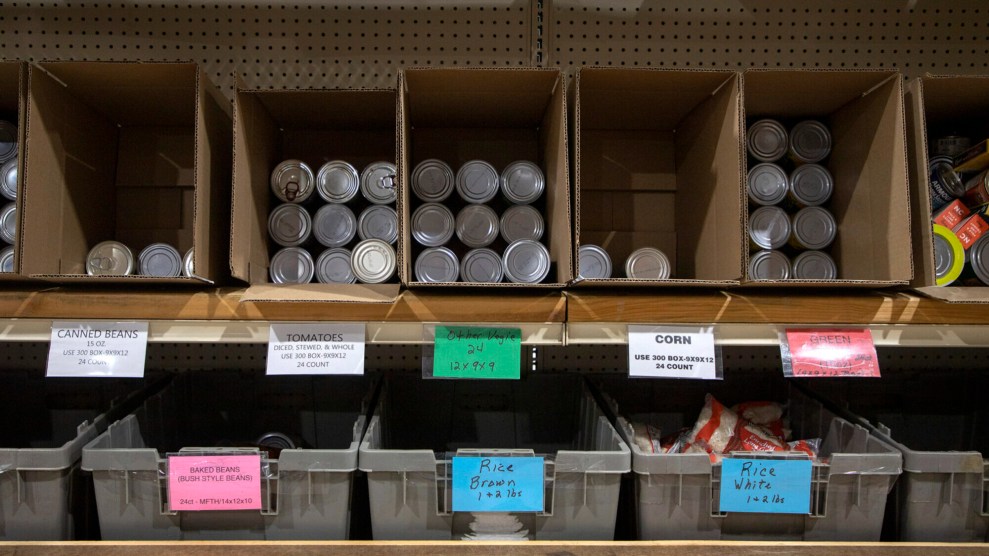
The food sorting station at The Des Moines Area Religious Council.
Emily Kestel/FERN
The increased demand comes as food banks, too, struggle to keep up with rising costs. Higgerson’s food bank has 20 refrigerated diesel trucks that pick up and distribute food across the region. “We put about 2,000 gallons of diesel fuel a week in those trucks to keep the food flowing in,” he said. “And that’s $10,000 more a week right now—that is more than we budgeted for, quite honestly.”
Clifton Rockett, director of Donor Services and Community Engagement at the Mid-South Food Bank, which serves parts of Tennessee, Arkansas, and Mississippi—all of which have ended emergency SNAP allotments—said there’s been a sharp uptick in demand at the food bank’s mobile food distributions. After a surge early in the pandemic, the number of people coming to the distribution sites had dropped to 200 or 300. But now they’re starting to see 500 to 700 people some days.
“Now that people are cut off, they’re back out trying to find food and trying to get those resources,” he said.
The Des Moines Area Religious Council, which operates a network of food pantries, is bracing for a similar increase in need. Already, demand for food has been rising in the last three months as benefits like monthly child tax credit payments have ended, said the organization’s CEO, Matt Unger.
“We’re trying to get in front of things and make sure we have enough food on hand that we can provide to the network if we get a big rush of new folks coming through,” Unger said.
The recovery has been uneven, Unger said, and people with the lowest incomes are always the last to rebound from any economic downturn. Furthermore, inequality and hunger were already widespread before the pandemic, and nothing has really changed. “We’ve solved nothing,” he said. “And now, everything costs more.”
Census data suggest food insecurity has worsened overall during the last year. In March 2022, 10.3 percent of respondents to the U.S. Census Bureau’s Household Pulse Survey reported that they sometimes or often did not have enough to eat during the previous week, compared to 8.8 percent in March 2021.
The USDA doesn’t track whether food insecurity rates are higher in states that have cut emergency SNAP benefits than in those that have not. But survey data made available to FERN from Providers, an app used by 5 million SNAP recipients, show a worrying signal. In March, 48 percent of SNAP users from states that have discontinued emergency allotments said they were worried that their food would run out before they had money to get more, compared to 35 percent of survey respondents from states that haven’t cut benefits.
In Florida, during the four weeks spanning late May to late June 2021, before SNAP emergency allotments were cut, 19.4 percent of SNAP recipients said they sometimes or often did not have enough to eat during the previous week, according to the Pulse survey. But from mid-August to mid-September, after emergency allotments ended, that number jumped to 47.9 percent. Missouri showed a similar pattern. It isn’t a perfect measure of the food-insecurity problem—in Arkansas, for instance, the number of SNAP recipients who reported struggling to get enough food actually dropped after the emergency allotments ended—and numerous other factors, like local economic conditions and the availability of unemployment benefits, and even the timing of the survey, all play a role. But the loss of these benefits is clearly affecting a lot of people.
The federal government will eventually end the emergency allotments, but there are steps it can take to cushion the blow, Vollinger said. Several bills are already in Congress that would expand SNAP’s reach. For example, the Close the Meal Gap bill, sponsored by Rep. Alma Adams, a North Carolina Democrat, and Sen. Kirsten Gillibrand, a Democrat from New York, would increase the baseline amount of SNAP benefits, remove limits on how much families can deduct from their income for rent or mortgage—which penalizes larger families and people who live in high-rent areas—and end limits on how long people can receive SNAP.
Barring more sweeping action, people will be left to stretch their benefits as far as they can. Cecelia Proffit, of Iowa City, says everything will be tighter as her family loses about $250 in SNAP benefits this month. She has a 3-year-old and a 10-month-old baby and the family survives on her husband’s teaching assistant salary; he’s getting his Ph.D. at the University of Iowa.
With less SNAP money, Proffit will go back to calculating cereal prices down to the ounce. She’ll buy fewer fresh fruits and vegetables, and also fewer convenient kid foods like cheese sticks and baby puffs. She’ll also cut out the few modest joys, like popsicles or the ice cream sandwiches she bought on her daughter’s birthday.
And it’s not just the SNAP benefits the family is losing; they’ve used up almost all of their emergency heating funds just as their allotment from the Women, Infants, Children program is shrinking and monthly child tax credit payments have stopped. Getting a job and putting the kids in daycare isn’t really an option, Proffit says, since child care is so expensive and her husband is immunocompromised and they worry about the kids bringing Covid-19 home.
“The pandemic’s not really over for us,” she said, “but all the supports are going away.”
In Des Moines, Tara Kramer said she feels like “collateral damage” in the governor’s push to cut aid. Now she’s trying to figure out how she can piece together a consistent healthy food supply.
With the extra SNAP allotments in place, Kramer could get her groceries delivered to her home, which was helpful since she uses a walker and is at risk of complications if she gets Covid. Now, getting food is much less certain and way more difficult. On a freezing day a couple of weeks ago, she waited in line outdoors at a mobile food pantry. One night last week, her dinner came from a “burrito ministry”—a family on bikes with a backpack full of burritos—that showed up at her building. And she recently learned that a church near her house serves free lunches, so she knows that she can get at least one meal each day. But this patchwork is no substitute for having enough resources to choose what she needs.
“There’s just a lot of fear and uncertainty,” she said. “I can’t just make food magically appear. I can’t go out and hustle more money. These are the resources I have. And I just need to figure out what my new normal is.”
